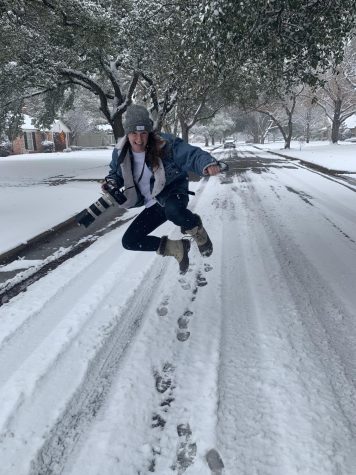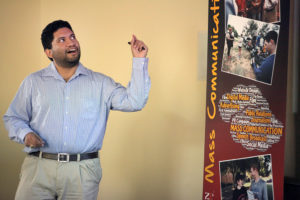
Making money with Twitter; how to create personal filters on Snapchat; social media’s application in the business world; the struggles of college life. These were some of the many topics of conversation at Social Media Day.
The aim of Social Media Day was to teach students new, ways to use their social media accounts as well as attract potential new students to the mass communication department.
Bradley Wilson, assistant professor of mass communication, said, “It all started because we wanted to do a recruitment activity. We wanted to do something that was specialized to our department to get the high school students in here to see what we have to offer.”
The Department of Mass Communication was not the only one sponsoring the event.
“I wanted it to be an interdepartmental cooperation. It couldn’t just be mass comm,” Wilson said.
Along with mass communication, the Division of Student Affairs and Enrollment Management and Office of Public Information and Marketing helped sponsor the event.
“It became a university event,” Wilson said.
The morning focused on introducing students to better ways to use social media, while the afternoon was spent teaching students how social media is evolving the business world.
“Hopefully they’ll associate mass comm with learning and having fun,” Wilson said.
Twitter: From Start to Finish in 140 Characters
Wilson started off the event by challenging students to look at Twitter from a new perspective.
“I wanted them to get exposed to Twitter not just as consumers, but as producers,” he said.
He stressed the fact that the way students use their accounts will play a role in landing jobs they want in the future.
“How can you ‘make money’ on Twitter? Well, that’s your brand,” Wilson said. “You can make money on Twitter by building your brand, so when you start applying for jobs people will look at your brand and go, ‘he’s valuable to us.'”
Time invested is important when building a brand, according to Wilson.
He said, “You can’t just do that overnight. You have to build that brand over a long period of time because people aren’t just going to look at yesterday’s tweets. They’re going to look at yesterday’s, the week before that, the month before that, the year before that, to get a feel for the brand.”
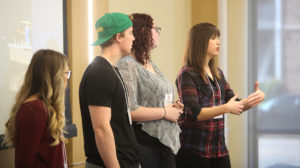
From Ghosts to Leaders: The New World of Snapchat
A J Lopez III, the MSU social media coordinator, spoke about giving Snapchat a broader purpose.
“The thing we want them to know is how much more you can do with Snapchat than just sending videos to one another and trying to get your snap streak up,” Lopez said.
He showed students, step by step, how to create their own Geofilters for Snapchat.
Lopez said, “We wanted them to know there are ways to advertise with Geofilters. Geofilters can tell stories across platforms.”
There is no social media like Snapchat, according to Lopez.
“It’s a more personal way to follow people. It’s a different media entirely than what Facebook, Twitter, and Instagram are offering,” he said.
Optimizing Your YouTube Channel
Mitzi Lewis, associate professor of mass communication, said, “It’s all about the audience, and you’ve got to have good content.”
Lewis gave the students tips on how to attract and keep a target audience. She showed them ways to use thumbnails, titles, descriptions, and tags to their advantage.
“When you are doing all of this, you’re thinking about your audience,” she said.
Viewers won’t subscribe if the channel doesn’t give them something they want, according to Lewis.
She said, “It’s got to have some benefit for them. Otherwise, they are not going to watch. Maybe that’s entertainment. Maybe that’s learning how to do something.”
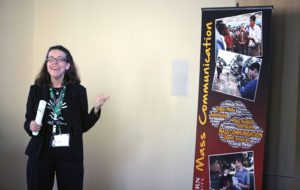
Associate professor Mitzi Lewis discusses YouTube with more than 100 attendees, mostly high school and college students. In addition to discussing how to build YouTube channels that people will watch, Lewis, and conference assistant Garrett Hutchinson, gave out candy to students who answered students correctly.
Social Media for Journalists: How to Utilize It, and Why It Matters
Orlando Flores, Jr., Times Record News digital contact producer, and Chris Collins, Times Record News investigative reporter, gave the students an inside perspective on how social media is changing news paper media.
Flores said, “The big thing was that social media— whether it’s Facebook, Twitter, YouTube, any of that— is a big driver on traffic, and how our stuff is going to be seen by people more than it’s ever been, and it’s only growing.”
He said that of all social media, Facebook links bring in the most page views to the Times Record News website.
“Chris, my colleague, was more so focused on what you as a reporter would need to do for Twitter,” Flores said.
Collins stressed the importance of finding a way to advertise on Twitter in a way that is different than what other people are doing.
Building a Better Community
Ann Arnold-Ogden, community marketing director with Chamber of Commerce, talked about social media’s impact outside of business and news.
“Social media is being used more broadly by, not just companies but, also city government as a way to get information out about events, to show visitors what we love about our community, or as a way to attract businesses to come to our community,” Arnold-Ogden said.
She passed out her business cards and encouraged students to bring her new ideas on how to advertise with social media.
“More and more companies are needing these skills that young people already know how to do,” she said, “It’s not just a way to share selfies and amazing vacation photos anymore.”
Introduction to program
In the middle of the sessions, time was taken out to talk to high school students specifically about the Department of Mass Communication, the new building, and the challenges of being in college.
Jim Sernoe, associate professor of mass communication, said, “After 30 years of being cramped into space that was too small for us, we finally got permission to build a new building, about $7 million worth. There will be all new equipment, new studio, new news room, edit bays, work cafe, collaboration areas. It’s going to be pretty state of the art.”
Small colleges, according to Sernoe, are better to attend than larger schools.
“When you are at a small school, you are not just a number. Your professors know you,” he said.
The event’s student panel, with mass comm juniors Kara McIntyre, Nizhoni Terronez, and Avery Whaite, and mass comm senior Megan Piehler, agreed with Sernoe’s favoring small schools.
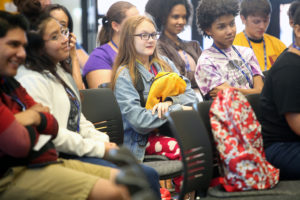
QUOTES FROM ATTENDEES, PARTICIPANTS
Bradley Wilson, mass communication assistant professor | “I had to think about YouTube in a way I hadn’t thought about YouTube before, and that’s the point.”
Jacob Bachert, Burkburnett High School student | “It really sparked my interest in mass communication.”
Saul Alarcon, Hirschi High School senior, yearbook editor | “I really liked the students and how they talked about the bigger picture.”
Skylar Baker, Hirschi High School senior, yearbook editor | “When the students came and talked to us, it made me feel a lot better about coming here, because I was really nervous and kind of scared because I didn’t know what to look for.”
Jenna Black, Hirschi High School junior | “I learned a whole bunch more about social media that I didn’t already know. I’m excited to get to use more of that stuff.”
Zac Reed, Burkburnett High School sophomore | “I learned quite a bit about how to use social media in your favor to help your business or your yearbook.”
Kayrah Lee, Burkburnett High School junior | “I want to go to Tech personally. I’ve looked at MSU, but now that I’ve seen it and talked to students, it’s definitely going to be a choice for me.”
Bradley Wilson, mass communication assistant professor | “For the high school kids, I bet they are blocked in a lot of their schools. They’re told not to use social media. That’s ridiculous. Why don’t we teach them how to use social media responsibly?”

















